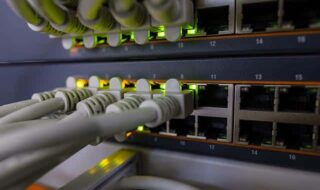The change to IPv6 dual stack will be a major problem for many companies and Internet users. All systems must be converted to the new protocol version by 2025, but the challenge is that hardly anyone is working with it yet. How is this change supposed to succeed?
What is IPv6 Dual Stack?
IPv6 dual stack is a Concept, which uses both IPv4 and IPv6 protocols simultaneously. This allows users to Webseiten and other online resources that are only accessible under IPv6. However, users using IPv6 Dual Stack must configure their devices to handle both IPv4 and IPv6 packets.
The acceleration of the Internet
Using IPv6 Dual Stack can help accelerate the transition period from IPv4 to IPv6. By using both logs ensures that all online resources are still accessible. It also enables networksto participate in the global IPv6 rollout without having to completely abandon their IPv4 infrastructure.
The advantages of IPv6
IPv6 is the new version of the Internet Protocol and offers a variety of advantages over the old IPv4. On the one hand, it is much more efficient and can do more data process. It is also robust against failures and can therefore ensure a reliable connection.
However, moving to IPv6 is not an easy process. Nevertheless, it is worth switching to dual stack by 2025, as the advantages of IPv6 will become more and more noticeable in the future.
The 7 advantages of IPv6:
More efficient processing of dataRobust against failuresReliable connectionLower costs for the Implementation Longer addresses for more securityLarger number of available IP addressesSet up a central management for IP addressesSupport new technologies such as VoIP and IPTV
The challenges of IPv6
IPv6 is an important issue for the future of the Internet. It ensures that all devices can communicate with the Internet. This is important as more people access the internet and more devices are online.
Unfortunately, there are some challenges with moving to IPv6.
The top 3 biggest challenges:
– Compatibility with existing systems
– The costs of the change
– Training of employees and users
Nevertheless, it is important that companies and organizations rise to this challenge and have switched to IPv2025 by 6.
The switch to IPv6
The transition to IPv6 will not take long and the transition should be completely completed by 2025. This is an important step because IPv4 is no longer sufficient and many devices have already switched to IPv6. Although there are still some obstacles, the change is inevitable and will certainly progress further in the coming years.
Why migrating to IPv6 is necessary
The migration to IPv6 is necessary because of the number of available IPv4 addresses is exhausted. IPv6 offers greater address capacity and allows for better management of the IP addresses. In addition, IPv6 offers some new features that will be beneficial for the future development of the Internet.
How long will it take to migrate to IPv6?
The migration to IPv6 will take several years and will likely last until 2025. Many companies have already started converting their infrastructure to the new IP version. This is a complex and laborious process that takes a lot of time.
The advantages of IPv6 over IPv4
The advantages of IPv6 over IPv4 are numerous. For one thing, IPv6 offers a much larger addressing capacity than IPv4. In addition, IPv6 is much more efficient at packet forwarding and offers better Safety through the use of IPsec.
Other advantages of IPv6 include the ability to to serve multiple domains at the same time, the excellent performance for voiceover connections and the increased average usage in companies.
The disadvantages of IPv6 compared to IPv4
The main disadvantages of IPv6 over IPv4 are compatibility and stability. Because IPv6 is a new protocol, it is not as compatible with existing IPv4 systems. IPv6 is also more susceptible to failures because it is not yet as stable as IPv4.
According to the IPv6 association ICC, IPv6 is 95 percent compatible with IPv4. However, there are some areas that are not yet fully compatible. For example, Forwarding Detection and Recovery (FDR) does not work with IPv6.
Compatibility of IPv6 and IPv4
IPv6 and IPv4 compatibility is an important issue to be considered by 2025. Through the Using a dual stack, both IPv6 and IPv4 addresses can be used. This enables smooth communication between the two protocols.
To ensure an optimal connection between IPv6 and IPv4, it is important that the devices already in the user's hands already support IPv6 and IPv4. Also Provider should pay attention to these specifications when configuring their networks.
The IP and ASN Handbook
Until recently, the Internet was a rather disorderly affair. There was no uniform system to deal with the different Network to connect with each other. However, this has changed with the advent of the Border Gateway Protocol (BGP). BGP is a method with which Network can be connected by making their routes known. Each Network, which participates in BGP, is called an Autonomous System (AS).
Internet Service Provider (ISP)
An AS can consist of one or exist in several networks and is usually operated by an Internet Service Provider (ISP). Each AS has a unique number called an Autonomous System Number (ASN). The ASN is exactly the same as the Autonomous System Prefix (ASP) that each Network must enter into your provider in order to communicate with BGP.
Using BGP allows ISPs to use their customers to be identified based on specific routes. In addition, an ISP can influence the connection quality of the rest of the Internet by changing its customers connects using specific routes.
Alternatives to an IPv6 dual stack
Future Internet users probably won't care which one Technology is in the background of their connection. Nevertheless, it is important that Network are prepared for the future and the right investments are made. By 2025, all companies should have switched to an IPv6 dual stack. This means that both IPv4 and IPv6 traffic are supported.
IPv4 and IPv6 together?
However, there are some Alternatives to a complete switch to IPv6. One possibility is to continue to use IPv4 and only use some parts of the network to switch to IPv6. However, this is not a long-term solution as IPv6 already requires more bandwidth than IPv4. Another alternative is to only use IPv6 in a few areas, for example in areas with high data traffic or where IPv4 access is vulnerable.
Conclusion
By 2025 there will be a full dual stack of IPv4 and IPv6. This is a very important goal as it ensures that all devices and services are compatible with both IPv4 and IPv6. This allows all users to have full access to all services without having to worry about compatibility issues.





